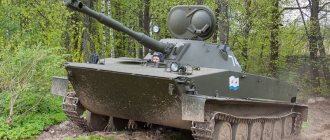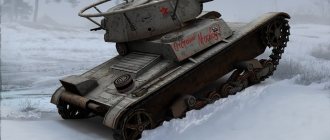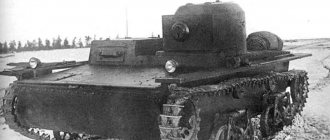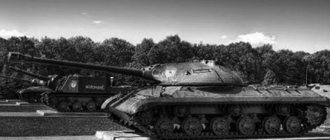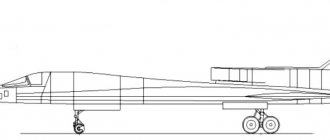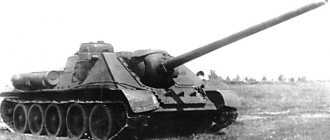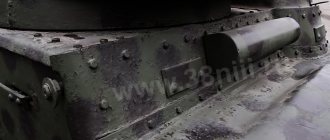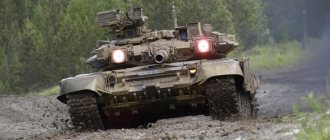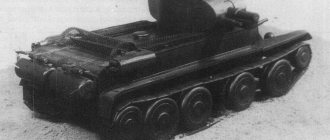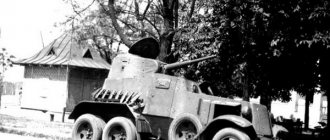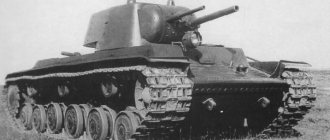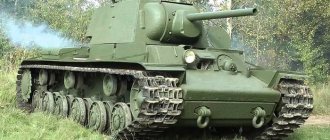This vehicle is a collectible vehicle and does not require research.
100 610
560 23300
95 1200
| Result: | |
| Credits: | 25110 |
| Experience: | 755 |
Combat effectiveness
- excellent 47 mm gun with good damage and penetration;
- 4 crew members compared to AT-1.
Crew
Equipment, equipment and ammunition
- The camouflage network
will reduce the visibility of a stationary vehicle.
Standard set of equipment: repair kit
.
The bulk of the ammunition consists of armor-piercing shells; it makes sense to carry several special sub-caliber shells for encounters with armored opponents. High-explosive fragmentation shells of this caliber are completely ineffective.
Historical reference
On May 28, 1930, the Soviet procurement commission, headed by I.A. Khalepsky, head of the newly created Department of Mechanization and Motorization of the Red Army, entered into a contract with the English company Vickers for the production of 15 double-turret Vickers Mk.E mod.A tanks for the USSR. The first tank was shipped to the customer on October 22, 1930, and the last one on July 4, 1931. Soviet specialists also took part in the assembly of these tanks. Each combat vehicle purchased in England cost the Soviet Union 42 thousand rubles. (in 1931 prices). For comparison, let’s say that the T-19 “main escort tank” manufactured in the USSR in August of the same year cost over 96 thousand rubles. In addition, the B-26 tank (British vehicles received this designation in the USSR) was easier to manufacture and operate, and also had better mobility. All these circumstances predetermined the choice of the UMM Red Army. Work on the T-19 was curtailed, and all efforts were devoted to mastering the serial production of the B-26.
On February 13, 1931, by decree of the Revolutionary Military Council of the USSR, the Vickers-26 tank was adopted by the Red Army under the designation T-26. Its production was supposed to be launched at the Chelyabinsk Tractor Plant under construction, then at the Stalingrad (also under construction), and at the latter it was planned to create a special workshop capable of producing up to 10 thousand tanks per year in wartime. But in the end they settled on the Leningrad one, which already had experience in tank building. Design work to prepare for serial production, as well as all further work to modernize the tank, was carried out under the leadership of S.A. Ginzburg.
Vitality
Compatible Equipment
Modules:
Turrets/guns
| Lv. | Tower | Armor (mm) | Rotation (deg/sec) | Review (m) | Weight, kg) | Price (credits) |
| II | T-26 arr. 1936–1937 | 30/15/15 | 44 | 280 | 850 | 670 |
Compatible weapons:
| Lv. | gun | Penetration (mm) | Damage (HP) | Rapid fire (rounds/min) | Spread (m/100m) | Mixing (c) | BC | Weight, kg) | Price (credits) |
| I | 37 mm B-3 | 40/64/19 | 36/36/40 | 26.09 | 0.46 | 2.3 | 160 | 77 | 1 950 |
| III | 37 mm ZiS-19 | 58/92/19 | 40/40/50 | 26.09 | 0.39 | 2.3 | 140 | 200 | 4 250 |
| II | 45 mm 20K | 51/88/23 | 47/47/62 | 26.09 | 0.46 | 2.3 | 136 | 250 | 2 530 |
| Lv. | Tower | Armor (mm) | Rotation (deg/sec) | Review (m) | Weight, kg) | Price (credits) |
| III | T-26 arr. 1938 | 15/15/15 | 46 | 310 | 1050 | 1 440 |
Compatible weapons:
| Lv. | gun | Penetration (mm) | Damage (HP) | Rapid fire (rounds/min) | Spread (m/100m) | Mixing (c) | BC | Weight, kg) | Price (credits) |
| I | 37 mm B-3 | 40/64/19 | 36/36/40 | 26.09 | 0.46 | 2.3 | 160 | 77 | 1 950 |
| III | 37 mm ZiS-19 | 58/92/19 | 40/40/50 | 26.09 | 0.39 | 2.3 | 140 | 200 | 4 250 |
| II | 45 mm 20K | 51/88/23 | 47/47/62 | 26.09 | 0.46 | 2.3 | 136 | 250 | 2 530 |
Engines
| Lv. | Engine | Power (hp) | Fire probability (%) | Weight, kg) | Price (credits) |
| I | T-26 | 90 | 20 | 545 | 770 |
| II | T-26F | 130 | 20 | 545 | 1 500 |
Chassis
| Lv. | Chassis | Max. load (t) | Turning speed (gr/sec) | Rmin | Weight, kg) | Price (credits) |
| I | T-26 | 10.2 | 50 | B/2 | 1 880 | 340 |
| II | T-26M | 12.7 | 52 | B/2 | 1 880 | 680 |
Radio stations
| Lv. | Radio station | Communication range (m) | Weight, kg) | Price (credits) |
| III | 71-TK-3 | 300 | 100 | 570 |
Order of studying modules:
| Chassis | gun | gun | Tower | Engine | |
| Result: Credits: 10,400 Experience: 810 | |||||
| T-26M | 45 mm 20K | 37 mm ZiS-19 | T-26 arr. 1938 | T-26F | |
| 125 experience - 680 credits | 125 experience - 2530 credits | 160 experience - 4250 credits | 270 experience - 1440 credits | 130 experience - 1500 credits |
More details on the research.
- The T-26M chassis will add carrying capacity and also increase the maneuverability of the tank.
- 45 mm 20K gun - will increase penetration and damage.
- 37 mm ZiS-19 gun - will increase penetration and reduce dispersion, but also reduce one-time damage.
- Tower T-26 arr. 1938 - Increases turning speed and viewing range.
- T-26F engine - slightly increases the dynamics of the tank.
Tank T-26 in World of Tanks
Research and leveling
So, in addition to the stock T-26, we get a 23mm VYa automatic cannon, inherited from the elite MS-1, which will still be useful to us. The carrying capacity of the base chassis is enough to install absolutely all modules, so if you prefer aimed fire at the enemy to a fun rush, then you can immediately start researching the top gun (125+160 experience).
If you prefer a nimble, maneuverable tank rather than a stationary firing point, then first of all you will have to study the top chassis (125 experience) and top engine (125+175 experience), and the already unlocked automatic cannon, in my opinion , just what is needed to “twist” the enemy.
The top tower will add to you, in addition to 52 degrees/sec (instead of 50), 30 units of strength, and this is as much as 20% of the drain (270 experience). There remains a radio station that gives an advantage at only 40 meters, but on the other hand, it will be useful to us when leveling up other tanks, and besides, these 40 meters can play a decisive role in battle (95 experience).
In total, to upgrade the elite T-26 you will need 1075 units of experience.
Crew:
- Crew commander (radio operator);
- Driver mechanic;
- Gunner (Loader).
Learning additional skills for the crew:
Standard crew for Active Actions:
| 1 | 2 | 3 | 4 |
First of all, we learn the “Repair” , and the “Sixth Sense” . “Repair” skill speeds up the repair of damaged modules, and the “Sixth Sense” will allow you to determine whether your tank has been detected by the enemy. All crew members should study “Combat Brotherhood” , which should be studied by all crew members at the same time to improve the level of proficiency in the specialty. “Eagle Eye” skill , which increases the viewing range. For the gunner we learn the skill “Smooth turret rotation” , which reduces the spread when turning the turret; and the Sniper , which increases the chances of causing damage to modules and crew members. For the driver mechanic, we learn the “Smooth Move” , which reduces the dispersion of the gun in motion; and the “Off-Road King” , which reduces resistance on soft and medium soils when driving.
Studying skills and abilities of crew members for defense:
| 1 | 2 | 3 | 4 |
Learning additional skills and abilities is approximately the same as in active battle, but when defending, you need to replace “Repair” “Disguise” , which will allow you to remain unnoticed by the enemy team.
Equipment, gear and ammunition:
List of equipment that can be installed on the T-26:
Equipment for the T-26 tank:
Active-action tactics, it is worth installing the equipment “Reinforced aiming drives”, “Improved ventilation” and “Coated optics” . On the first slot we install complex equipment: Reinforced aiming drives, which increases the gun aiming speed by 10% . On the second slot we install complex equipment Improved ventilation, which increases the level of proficiency in the main specialty and additional skills by 5% . On the last slot we install complex equipment Coated optics, which increases the viewing radius by 10% .
For the Ambush-Sniper , it is worth installing the equipment “Reinforced aiming drives”, “Stereo tube” and “Camouflage net” . On the first slot we install complex equipment: Reinforced aiming drives, which increases the gun aiming speed by 10% . On the second slot we install the removable Stereo Tube equipment, which increases the viewing radius 3 seconds after stopping. On the last slot we install the removable equipment Camouflage Network, which reduces the visibility of a stationary tank after stopping after 3 seconds.
Equipment:
List of equipment that can be installed on the T-26:
The equipment should be equipped with a standard set of equipment: Small repair kit , Small first aid kit , Hand fire extinguisher . The fire extinguisher can be replaced with Lend-Lease oil , which will increase engine power by 5% . For tournaments or when there are a lot of credits, you can replace the fire extinguisher with Extra Ration 10% to all skills .
Ammunition:
37 mm ZiS-19 gun , we’ll take most of the armor-piercing shells, but against more armored opponents it’s worth taking a few premium sub-caliber shells, which will make the game easier. High-explosive fragmentation shells will be useful for us to shoot down the capture of the base and finish off opponents with a small margin of safety. The total ammunition load is 140 shells.
45 mm 20K gun , we’ll take most of the armor-piercing shells, but against more armored opponents, it’s worth taking a few premium sub-caliber shells, which will make the game easier. High-explosive fragmentation shells will be useful for us to shoot down the capture of the base and finish off opponents with a small margin of safety. The total ammunition load is 136 rounds.
Assembly of equipment, equipment and ammunition - Active actions:
| 110 | 20 | 6 | ||||||
Assembly of equipment, equipment and ammunition - Defense:
| 110 | 25 | 5 | ||||||
T26E3 Eagle 7
This vehicle is a promotional premium vehicle and does not require upgrading additional modules; it has “Elite” status, brings more credits and experience for each battle, and also has a number of other advantages.
Combat effectiveness
Sergeant Early's T26E3 Eagle 7 is now in the game!
- good vertical aiming angles;
- good review.
- weak armor;
- mediocre dynamics.
Crew
Equipment, equipment and ammunition
Screenshot gallery
Rating T26E3 Eagle 7
History of changes
- Introduced to the main server as a promotional Tier VII American medium tank.
- Available for the first time in the Premium Store from August 21 to August 25, 2022.
- The car has become available for sale in the in-game store.
More detailed information about the technique:
The T-26 tank can be used in the role of a “sniper”, who will be behind cover and defending the base, as well as in a support role, being in the thick of things, but behind the allies. It is not worth engaging in duels in open areas, due to very weak armor and large dimensions.
Support tactics:
This tactic is the best for the T-26 battle tank. Thanks to the 45 mm 20K and 37 mm ZiS-19 guns, you can confidently inflict damage on the enemy due to their high penetration. Good dynamics and maneuverability allow you to take a shot and move to a safe position. The armor of the tank is very weak, even the frontal part is pierced by shells from semi-automatic guns. Therefore, it is worth staying behind your more armored allies, who will protect you from enemy projectiles, and you will deal retaliatory damage.
Defense tactics:
This tactic is suitable for players who have learned to hide behind cover. Thanks to the tank's short length, you can hide behind almost any cover, leaving only the turret with the gun. However, it is quite difficult to hide the tank in vegetation due to its high silhouette. But if you use the Camouflage Network equipment, camouflage and the Disguise skill, then your chances of remaining undetected are much higher. The 37 mm ZiS-19 gun is most effective at long distances, thanks to its high accuracy and penetration.
Bottom line: the tank is great for fighting behind allies and defending a base while behind cover. Such powerful weapons allow you to confidently deal damage to almost all vehicles that may be encountered in battles of your level. However, such guns had to be paid for with very weak armor.
T-26[guide outdated]
Changes in patch 1.9:
- The ammunition capacity of the 37 mm B-3 gun has been changed from 160 to 320 shells
- The ammunition capacity of the 37 mm ZiS-19 gun has been changed from 140 to 280 shells
- The ammunition capacity of the 45 mm 20K gun has been changed from 136 to 270 shells
- Repair costs reduced by 50%
- Profitability reduced by 27%
- Strength with T-26 turret mod. 1938 changed from 180 to 360 units
- Strength with T-26 turret mod. 1936–1937 changed from 150 to 340 units
This topic will discuss one of the light Soviet Tier 2 tanks - the T-26. Excellent maneuverability and a penetrating weapon with good accuracy, and at the same time a low maximum speed and insignificant armor, this is what distinguishes it from other light vehicles at this level.
- Introduction
- Historical reference
- Research and purchase
- Assessing the performance of a stock tank
- The optimal way to level up, combat is not in the top configuration
- Assessing the characteristics of a top tank
- Conducting combat in a top-end configuration
- Crew, skills and abilities
- Selection of equipment and equipment
- Comparison of guns, main dangerous opponents
- Conclusion
For those who have been in the world of tanks for a long time, the T-26 will become a completely offensive machine with an excellent weapon and good inclinations to destroy any enemy. 2. Historical background. The information was taken from here, who is too lazy to go through it, everything is under a spoiler. On May 28, 1930, the Soviet procurement commission, headed by I.A. Khalepsky, head of the newly created Department of Mechanization and Motorization of the Red Army, entered into a contract with the English company Vickers for the production of 15 double-turret Vickers Mk.E mod.A tanks for the USSR. The first tank was shipped to the customer on October 22, 1930, and the last one on July 4, 1931. Soviet specialists also took part in the assembly of these tanks. Each combat vehicle purchased in England cost the Soviet Union 42 thousand rubles. (in 1931 prices). For comparison, let’s say that the T-19 “main escort tank” manufactured in the USSR in August of the same year cost over 96 thousand rubles. In addition, the B-26 tank (British vehicles received this designation in the USSR) was easier to manufacture and operate, and also had better mobility. All these circumstances predetermined the choice of the UMM Red Army. Work on the T-19 was curtailed, and all efforts were devoted to mastering the serial production of the B-26. On February 13, 1931, by decree of the Revolutionary Military Council of the USSR, the Vickers-26 tank was adopted by the Red Army under the designation T-26. Its production was supposed to be launched at the Chelyabinsk Tractor Plant under construction, then at the Stalingrad (also under construction), and at the latter it was planned to create a special workshop capable of producing up to 10 thousand tanks per year in wartime. But in the end they settled on the Leningrad one, which already had experience in tank building. Design work to prepare for serial production, as well as all further work to modernize the tank, was carried out under the leadership of S.A. Ginzburg. In August 1931, the Defense Committee adopted a resolution on a tank building program in wartime conditions. In accordance with it, during the first year of the war, factories were to produce 13,800 T-26 tanks. Of course, this was a clear utopia, as was the production plan for 1931, released - 500 units. Already in February it was reduced to 300 units, with the condition that the first tank be delivered no later than May 1. But this also turned out to be unrealistic. In the spring of 1931, only preparations were underway for mass production of the T-26 using temporary, or, as they say today, bypass technology. In parallel, the assembly of two reference machines was carried out. Working drawings were mostly completed by May 1, and the technological process was approved on June 16. The plant began manufacturing tools and equipment for mass production. Assembly of the first ten production T-26s, the so-called “installation batch,” with non-armored steel hulls, was completed in the summer of 1931. In the fall, full-fledged production vehicles began to leave the factory buildings. In February 1932, a new plant No. 174 was organized on the basis of tank production. K.K. Sirken was appointed its director, and S.A. Ginzburg was appointed chief designer. Despite all these measures, the 1932 plan could not be implemented. Back in April, K.K. Sirken reported that the delay in tank assembly schedule was mainly due to the fault of subcontractors who were delaying the delivery of components and assemblies. In addition, the latter were of extremely poor quality. For engines, the percentage of defects reached 88%, and for armored hulls - up to 41%. In 1932, Plant No. 174 produced 1,410 tanks, presented 1,361 for delivery, and the troops accepted only 950. A similar picture was observed in the future. Nevertheless, by the second half of 1941, 11,218 tanks left the factory floors. The T-26 became the most popular combat vehicle of the Red Army in the pre-war period. The two-turret version, produced since 1931, was not much different from the British prototype. The tank's riveted hull had a box-shaped cross-section. On a turret box with a vertical frontal plate on ball bearings there are two cylindrical towers. Each of them provided space for one crew member. The driver was located in front of the hull on the right. Perhaps the only difference between the first production T-26 and the British vehicles was that their turrets were adapted to mount DT machine guns, and the Vickers tanks had round embrasures instead of rectangular ones. Since the autumn of 1931, tanks of the so-called “second series” began to be equipped with turrets of increased height with an observation window. An inspection slot was cut in the driver's hatch cover, but still without the triplex glass block. On March 1, 1932, a special casing began to be installed on the T-26 above the air outlet box, protecting it from precipitation, primarily snow. A month later, this casing began to be made as a single unit with the air outlet box. The tank was equipped with a carburetor, 4-cylinder air-cooled T-26 engine with a power of 90 hp, which was a copy of the English Armstrong Siddeley engine. The mechanical transmission consisted of a single-disc main dry friction clutch, a driveshaft, a five-speed gearbox, side clutches, final drives and band brakes located on the side clutch housings. The chassis on one side included eight double rubber-coated support rollers with a diameter of 300 mm, interlocked in pairs into four balancing bogies suspended on leaf quarter-elliptical springs, four rubber-coated support rollers with a diameter of 254 mm, a guide wheel with a crank tensioning mechanism and a front drive wheel with removable gear rims (pinion engagement). Tracks with a width of 260 mm were made of chromium-nickel or manganese steel. There were no means of external communication on linear ganks. To communicate between the commander and the driver, a “sound pipe” was initially installed, which was later replaced by a light signaling device. At the beginning of 1932, the question arose about strengthening the armament of the T-26, since machine-gun vehicles could not “hit enemy firing points at a long distance and defend against attacks by enemy fighter tanks.” In March 1932, the T-26 tank arrived at ANIOP, instead of the right turret of which a small gun turret of the experimental T-35-1 heavy tank, armed with a 37-mm PS-2 cannon, was installed. In April of the same year, such turrets were tested on two more T-26 tanks. The PS-2 gun had very good characteristics for its time, but was not adopted by the Red Army, since the GAU preferred the German 37-mm Rheinmetall cannon. Based on the latter, the B-3(5K) cannon was created and put into service. Compared to the PS-2, the B-3 had a smaller recoil and breech size, which made it possible to install it in a standard T-26 machine-gun turret with almost no modifications. However, Plant No. 8 named after Kalinin was unable to produce B-3 guns in the required quantities. In addition, since the summer of 1932, all existing B-3 guns were transferred to arm BT-2 tanks. Therefore, in the right machine-gun turret of the T-26, a 37-mm PS-1 cannon (or “Hotchkiss-PS”, well mastered by industry) was installed. However, the production of these guns was curtailed, and their stock in warehouses was not as large as expected. Therefore, it was necessary dismantle guns from T-18 and even Renault tanks transferred to SOAVIAKHIM or decommissioned. According to the rearmament plan, guns were to be installed on every fifth tank. In reality, several more such vehicles were produced: from 1627 double-turret tanks produced in 1931 - 1933 , the PS-1 gun was armed with about 450 vehicles.In March 1932, the 45-mm 19K anti-tank gun, developed at Plant No. 8, was adopted by the Red Army. Following this, its installation in a tank was designed, which was called the “45-mm tank gun model 1932" and factory index 20K. Compared to the GTS-2, the 20K tank gun had a number of advantages. Armor penetration increased slightly, the mass of the fragmentation projectile and the mass of the explosive increased sharply (from 0.645 kg to 2.15 kg) in the projectile - from 22 g to 118 g. Finally, the rate of fire was increased due to the introduction of a vertical wedge semi-automatic bolt. True, the debugging of semi-automatics took about four years, and only in 1935 guns with well-functioning semi-automatics for all types of ammunition began to arrive. In December 1932, the Defense Committee ordered the production of T-26 tanks with a 45-mm cannon. A new turret was designed for this gun, coaxial with a DT machine gun, for the T-26 and BT-2 tanks. Firing tests showed its complete reliability. Since 1935, tanks have been equipped with a 45-mm cannon mod. 1934. On this gun, the semi-automatic mechanical type was replaced by a semi-automatic inertial type. The latter worked fully only when firing armor-piercing shells; when firing fragmentation weapons - like a quarter of automatic weapons, i.e. opening the shutter and extracting the cartridges was done manually, and when the next cartridge was inserted into the chamber, the shutter closed automatically. This is explained by the different initial velocities of armor-piercing and fragmentation projectiles. Since 1935, tank hulls and turrets began to be manufactured using electric welding. The gun's ammunition capacity was reduced to 122 rounds (for vehicles with a radio station - 82), and the fuel tank capacity was increased. The tank's weight increased to 9.6 tons. In 1936, a removable rubber band was introduced on the road wheels, the tension mechanism was changed, and a second DT machine gun was installed in the turret niche. At the same time, the gun's ammunition load was reduced from 136 to 102 rounds (on tanks without a radio station), and the tank's weight increased to 9.65 tons. In 1937, DT anti-aircraft machine guns began to be mounted on turret mounts on parts of the vehicles. Two so-called “combat light” spotlights were installed on the gun, a new VKU-3 and a TPU-3 intercom were introduced. The engine was boosted, and its maximum power increased from 90 to 95 hp. In 1937, only radio tanks were produced, and with radio stations 71-TK-Z. The ammunition load of tanks with a radio station reached 147 rounds (107 for tanks without a radio) and 3087 rounds of ammunition. The mass of the tank was 9.75 tons. In 1938, instead of a cylindrical one, the T-26 was equipped with a conical turret with a 45-mm cannon mod. 1934. In the guns produced in 1937 and 1938, an electric shutter appeared, which ensured the firing of a shot by impact and using electric current. Guns with an electric shutter were equipped with a telescopic sight TOP-1 (since 1938 - TOS), stabilized and cortical plane. Unlike tanks of previous releases, which had one 182-liter fuel tank, the vehicle was equipped with two such tanks with a capacity of 110 and 180 liters, which made it possible to increase the power reserve. The combat weight was 10.28 tons. T-26 tanks with a conical turret and a straight turret differed in the presence or absence of a 71-TK-Z radio station with a handrail antenna, a rear turret DT machine gun, an anti-aircraft machine gun mount and “combat light” searchlights. In addition, there were two types of conical towers - with welded and stamped frontal shields. On some tanks, mainly with radio stations, a commander's panorama of the PTK was installed. In 1939, another modernization of the tank took place, during which a turret box with inclined armor plates was introduced, the rear machine gun was removed from some of the vehicles, and an additional ammunition rack for 32 rounds was installed in its place. As a result, the ammunition load on tanks without a radio station increased to 205 rounds and 3,654 (58 discs) rounds. On tanks with a walkie-talkie, it was 165 rounds and 3,213 rounds of ammunition. The TPU-3 intercom was replaced by TPU-2. The engine underwent some changes (the compression ratio was raised), after which its power reached 97 hp. The chassis has also undergone changes, mainly in the direction of strengthening the suspension. The vehicles with an inclined turret also differed from the T-26 tanks of the previous modification in the external stowage of spare parts. In 1940, the last cycle of changes to the design of the T-26 tank was carried out. Screens were installed on some vehicles during the war with Finland. The cemented armor of the turret box, 15 mm thick, was replaced with homogeneous armor 20 mm thick. In addition, a unified viewing device, a new turret ring and bakeliting of fuel tanks were introduced. The weight of the T-26 with screens exceeded 12 tons. On the basis of the T-26, a large number of special-purpose combat vehicles were produced: flamethrower tanks XT-26, XT-130 and XT-133, bridge layers ST-26, telemechanical tanks TT-26 and TU-26, self-propelled artillery units SU-5-2, artillery tractors, armored personnel carriers, etc.
Mobility
deg/s Turret rotation speed Horizontal speed. guidance
T-26 in the game
Research and leveling
This vehicle is a collectible vehicle and does not require research.
125 680
125 2530
160 4250
270 1440
130 1500
| Result: | |
| Credits: | 10400 |
| Experience: | 810 |
Combat effectiveness
In battle, the tank performs well both as a sniper, being in cover and defending the base from the enemy, and as a support tank, easily circling around the enemy and showering him with shells. Under no circumstances should you engage in close combat when the enemy is outnumbered - you won’t be able to “whirl” everyone. Sniper duels in open space should be avoided - the advantage in accuracy does not compensate for weak armor and large dimensions.
Support tactics
The best battle tactics for the T-26. Thanks to the 45 mm 20K and 37 mm ZiS-19 guns, you can inflict stable damage to enemies due to their high penetration. Good maneuverability and dynamics allow you to quickly deal damage and move to a safe position. However, there is no need to be a hero. The armor of the T-26 leaves much to be desired, and, by and large, the front of the hull cannot withstand shells from even semi-automatic guns. So, it's best to stick to your more armored allies, who can take the damage, giving you the opportunity to strike back.
Defense tactics
Another option for battle tactics. Thanks to its short length, you can hide behind any cover, leaving only the tower for enemy fire. However, the T-26 is difficult to hide in the bushes due to its high hull height. But if you have a camouflage net, camouflage or the Disguise skill, you have a much greater chance of remaining unnoticed. It is better to install a 37 mm ZiS-19 gun due to its high accuracy and the ability to successfully shoot at long distances.
- acceptable speed;
- good dynamics and maneuverability;
- precision gun 37 mm ZiS-19;
- high damage of 45 mm gun 20K;
- high armor penetration of guns;
- large margin of safety.
- very weak armor - even at long distances semi-automatic guns can penetrate it;
- large dimensions.
Crew
The crew needs to be pumped up based on your preferences, so we have two options for pumping up the crew. 1. Active First of all, we pump out repairs for everyone, there is no need to explain this - all active tanks need it. The second perk we pump out to the commander is the Sixth Sense, like a light bulb. And for the Gunner with Mech-Water, we pump out Smoothness. And the last perk is Combat Brotherhood. 2. Passive First of all, camouflage will improve invisibility. Commander Sixth Sense, Gunner - Smooth rotation of the turret, and Mech-Vod repair. The third perk for the Commander is Radio Interception, the Gunner is for repairs, and the Mech-Water is the King of the Off-Road.
Equipment, equipment and ammunition
- Improved ventilation
will improve all the main characteristics of the tank.
- Stereo tube
- will increase the viewing range of a stationary tank.
Standard set of equipment: repair kit
.
The bulk of the ammunition consists of armor-piercing shells; it makes sense to carry several special sub-caliber shells for encounters with armored opponents. High-explosive fragmentation is worth loading for lightly armored opponents, knocking down a grapple, or finishing off opponents with a small margin of safety.
Screenshot gallery
T-26 evaluation
- Warrior - for a powerful weapon that is not inferior to its “peers” in firepower and superior to them in armor penetration.
- Defender - for good combat effectiveness in defense.
- Tank sniper - for the accuracy of the top gun.
- Support - for a fast-firing weapon with low damage.
- Armor-piercer - for high armor penetration.
History of changes
- Reduced scatter in movement.
- Reverse speed increased, durability increased by 10.
- The traverse speed of the first chassis has been reduced to 52 degrees/sec.
- The viewing radius of the first tower has been increased to 320 meters.
- The viewing radius of the second tower has been increased to 350 meters.
- Profitability increased by 15%.
- The tank has been redesigned with a new visual quality.
- The ammunition capacity of the 37 mm B-3 gun has been changed from 160 to 320 shells.
- The ammunition capacity of the 37 mm ZiS-19 gun has been changed from 140 to 280 shells.
- The ammunition capacity of the 45 mm 20K gun has been changed from 136 to 270 shells.
- The cost of repairs has been reduced by 50%.
- Profitability reduced by 27%.
- Strength with T-26 turret mod. 1938 changed from 180 to 360 units.
- Strength with T-26 turret mod. 1936–1937 changed from 150 to 340 units.
